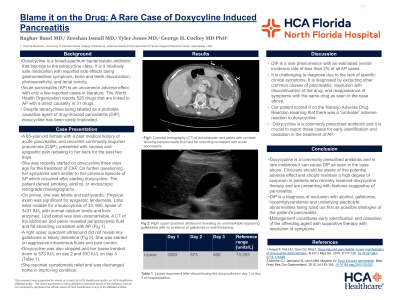Back


Poster Session D - Tuesday Morning
Category: Biliary/Pancreas
D0072 - Blame It on the Drug: A Rare Case of Doxycycline-Induced Pancreatitis
Tuesday, October 25, 2022
10:00 AM – 12:00 PM ET
Location: Crown Ballroom

Has Audio

Raghav Bassi, MD
University of Central Florida College of Medicine/HCA GME Consortium
gainesville, FL
Presenting Author(s)
Raghav Bassi, MD1, Zeeshan Ismail, MD1, Tyler Jones, MD2, George H. Cockey, MD, PhD1
1University of Central Florida College of Medicine/HCA GME Consortium, Gainesville, FL; 2University of Central Florida College of Medicine/HCA GME Consortium, Newberry, FL
Introduction: Doxycycline is a broad-spectrum bacteriostatic antibiotic that belongs to the tetracycline class. It is a relatively safe medication with reported side effects being gastrointestinal symptoms, bone and teeth discoloration, photosensitivity, and renal toxicity. Acute pancreatitis is an uncommon adverse effect with only a few reported cases in literature. The World Health Organization reports 525 drugs that are linked to acute pancreatitis with a direct causality in 31 drugs. Despite tetracyclines being labeled as a probable causative agent of drug-induced pancreatitis (DIP), doxycycline has been rarely implicated.
Case Description/Methods: A 65-year-old woman with a past medical history of pancreatitis, and community-acquired pneumonia (CAP), presented with nausea and epigastric pain radiating to her back for the past two days. She was recently started on doxycycline three days ago for the treatment of CAP. On further questioning, her symptoms were similar to her previous episode of acute pancreatitis which occurred after starting doxycycline. The patient denied smoking, alcohol, or recent endoscopic retrograde cholangiograms. On arrival, she was febrile and tachycardic. Physical exam was significant for epigastric tenderness. Labs were notable for a leukocytosis of 33, 900, lipase of 3431 IU/L with normal calcium levels, liver enzymes, and lipid panel. A CT of the abdomen and pelvis revealed peripancreatic fluid and fat stranding consistent with acute pancreatitis (Fig 1). A right upper quadrant ultrasound did not reveal any gallstones or biliary distention. She was started on aggressive intravenous fluids and pain control. Doxycycline was also stopped and her lipase trended down to 573 IU/L on day 2 and 530 IU/L on day 3. She reported symptomatic relief and was discharged home.
Discussion: DIP is a rare phenomenon with an estimated overall incidence rate of less than 2% of all acute pancreatitis cases. It is challenging to diagnose due to the lack of specific clinical symptoms. It is diagnosed by excluding other common causes of pancreatitis, resolution with discontinuation of the drug, and reappearance of symptoms with the same drug as seen in the case above. Our patient scored 8 on the Naranjo Adverse Drug Reaction meaning that there was a “probable” adverse reaction to doxycycline. Doxycycline is a commonly prescribed antibiotic and it is crucial to report these cases for early identification and cessation in the treatment of acute pancreatitis.

Disclosures:
Raghav Bassi, MD1, Zeeshan Ismail, MD1, Tyler Jones, MD2, George H. Cockey, MD, PhD1. D0072 - Blame It on the Drug: A Rare Case of Doxycycline-Induced Pancreatitis, ACG 2022 Annual Scientific Meeting Abstracts. Charlotte, NC: American College of Gastroenterology.
1University of Central Florida College of Medicine/HCA GME Consortium, Gainesville, FL; 2University of Central Florida College of Medicine/HCA GME Consortium, Newberry, FL
Introduction: Doxycycline is a broad-spectrum bacteriostatic antibiotic that belongs to the tetracycline class. It is a relatively safe medication with reported side effects being gastrointestinal symptoms, bone and teeth discoloration, photosensitivity, and renal toxicity. Acute pancreatitis is an uncommon adverse effect with only a few reported cases in literature. The World Health Organization reports 525 drugs that are linked to acute pancreatitis with a direct causality in 31 drugs. Despite tetracyclines being labeled as a probable causative agent of drug-induced pancreatitis (DIP), doxycycline has been rarely implicated.
Case Description/Methods: A 65-year-old woman with a past medical history of pancreatitis, and community-acquired pneumonia (CAP), presented with nausea and epigastric pain radiating to her back for the past two days. She was recently started on doxycycline three days ago for the treatment of CAP. On further questioning, her symptoms were similar to her previous episode of acute pancreatitis which occurred after starting doxycycline. The patient denied smoking, alcohol, or recent endoscopic retrograde cholangiograms. On arrival, she was febrile and tachycardic. Physical exam was significant for epigastric tenderness. Labs were notable for a leukocytosis of 33, 900, lipase of 3431 IU/L with normal calcium levels, liver enzymes, and lipid panel. A CT of the abdomen and pelvis revealed peripancreatic fluid and fat stranding consistent with acute pancreatitis (Fig 1). A right upper quadrant ultrasound did not reveal any gallstones or biliary distention. She was started on aggressive intravenous fluids and pain control. Doxycycline was also stopped and her lipase trended down to 573 IU/L on day 2 and 530 IU/L on day 3. She reported symptomatic relief and was discharged home.
Discussion: DIP is a rare phenomenon with an estimated overall incidence rate of less than 2% of all acute pancreatitis cases. It is challenging to diagnose due to the lack of specific clinical symptoms. It is diagnosed by excluding other common causes of pancreatitis, resolution with discontinuation of the drug, and reappearance of symptoms with the same drug as seen in the case above. Our patient scored 8 on the Naranjo Adverse Drug Reaction meaning that there was a “probable” adverse reaction to doxycycline. Doxycycline is a commonly prescribed antibiotic and it is crucial to report these cases for early identification and cessation in the treatment of acute pancreatitis.

Figure: Fig 1: Contrast tomography (CT) of the abdomen and pelvis showing an edematous pancreas with peripancreatic fluid and fat stranding
Disclosures:
Raghav Bassi indicated no relevant financial relationships.
Zeeshan Ismail indicated no relevant financial relationships.
Tyler Jones indicated no relevant financial relationships.
George Cockey indicated no relevant financial relationships.
Raghav Bassi, MD1, Zeeshan Ismail, MD1, Tyler Jones, MD2, George H. Cockey, MD, PhD1. D0072 - Blame It on the Drug: A Rare Case of Doxycycline-Induced Pancreatitis, ACG 2022 Annual Scientific Meeting Abstracts. Charlotte, NC: American College of Gastroenterology.
